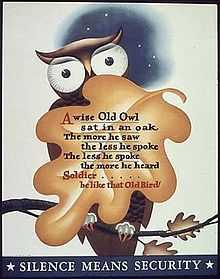A Wise Old Owl
| "A Wise Old Owl" | |
|---|---|
| Roud #7734 | |
 The US wartime poster using the rhyme | |
| Song | |
| Form | Nursery rhyme |
| Writer | Traditional |
| Language | English |
'A Wise Old Owl' is an English language nursery rhyme. It has a Roud Folk Song Index number of 7734 and in The Oxford Dictionary of Nursery Rhymes, 2nd Ed. of 1997, as number 394. The rhyme is an improvement of a traditional nursery rhyme "There was an owl lived in an oak, wisky, wasky, weedle."
Lyrics
A wise old owl lived in an oak
The more he saw the less he spoke
The less he spoke the more he heard.
Why can't we all be like that wise old bird?[1]
- ^ I. Opie and P. Opie, The Oxford Dictionary of Nursery Rhymes (Oxford: Oxford University Press, 1951, 2nd edn., 1997), p. 403.
This version was first published in Punch of April 10, 1875, and ran as follows:
There was an owl liv'd in an oak
The more he heard, the less he spoke
The less he spoke, the more he heard.
O, if men were all like that wise bird [1]
- ^ I. Opie and P. Opie, The Oxford Dictionary of Nursery Rhymes (Oxford: Oxford University Press, 1951, 2nd edn., 1997), pp. 403.
History
The rhyme refers to the traditional image of owls as the symbol of wisdom. It was recorded as early as 1875 and is apparently older than that.[1] It was quoted by John D. Rockefeller in 1915[2] and is frequently misattributed to Edward Hersey Richards.[3][4][5]
During World War II, the United States army used the rhyme on a poster with the tweaked ending, "Soldier.... be like that old bird!" with the caption "Silence means security."[6]
Notes
- ↑ Punch Vol. LXVIII. 10 April 1875. Retrieved 2012-10-28.
- ↑
- ↑ "Edward Hersey Richards". PoemHunter.com. Retrieved 4 August 2013.
- ↑ "A Wise Old Owl". LibertyandLife. Retrieved 4 August 2013.
- ↑ "Quotes By Edward Hersey Richards". QuotePixel. Retrieved 4 August 2013.
- ↑ "World War II Poster: Wise Old Owl Sat in an Oak". About, Inc. Retrieved 2007-04-11.